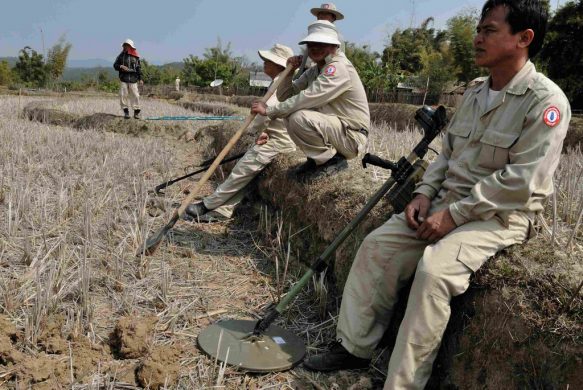Flere og flere lande vil afskaffe klyngevåben

Foto:
GENEVA, 30 August 2018 (The Monitor): Ten years after its adoption by the international community, the treaty banning cluster munitions has an extremely impressive record of compliance due to the steadfast commitment by States Parties to the agreement’s binding provisions, according to an annual monitoring report released today by the Cluster Munition Coalition at the United Nations (UN) in Geneva.
“Through this global agreement countries are ridding the world of the cluster munition scourge,” said Hector Guerra, director of the Cluster Munition Coalition (CMC). “Our global research demonstrates how the Convention on Cluster Munitions is the only truly effective measure against these indiscriminate weapons.”
Cluster Munition Monitor 2018 finds that States Parties to the convention have already destroyed 99% of their stockpiled cluster munitions, eliminating a collective total of more than 1.4 million cluster munitions and 177 million submunitions.
Fire lande har ødelagt sine klyngevåben på ét år
Since the last edition of Cluster Munition Monitor was published in August 2017, Croatia, Cuba, Slovenia, and Spain completed destruction of their stockpiled cluster munitions.
In 2017 alone, seven States Parties destroyed a total of 33,551 cluster munitions and more than 1.7 million submunitions.
Sri Lanka is the newest member of the Convention on Cluster Munitions, having acceded on 1 March 2018. This brings the total number of States Parties to 103.
Another 17 states have signed but not yet ratified the convention.
Last December, 142 states, including 32 non-signatories to the convention, adopted a key UN General Assembly resolution supporting the Convention on Cluster Munitions. Russia and Zimbabwe were the only countries to vote against.
“Many countries that have not joined the Convention on Cluster Munitions nonetheless express firm support for its goals and condemn new use of these weapons, which shows the stigma against cluster munitions is growing stronger” said Mary Wareham of Human Rights Watch, ban policy editor of Cluster Munition Monitor 2018.
“Full compliance demonstrates to those considering signing how the convention’s provisions are not overly burdensome or impossible to implement. Non-signatories should take note and renounce cluster munitions by joining the convention without delay.”
Syrien på trist førsteplads
Cluster Munition Monitor 2018 identified at least 289 new cluster munition casualties globally in 2017. This global number is certainly less than the actual total as many cluster munition attacks likely went unrecorded.
Of the total number of casualties worldwide in 2017, 187 were recorded in Syria, less than a quarter of the 860 recorded in 2016 in that country. Syrian government forces have continued to use cluster munitions in the past year, with the support of Russia. Over the past five-year period, 77% of recorded cluster munition casualties worldwide occurred in Syria.
A Saudi Arabia-led coalition of states has also continued to use cluster munitions in Yemen, but there has been a significant decline in the number of recorded attacks with these stigmatized weapons following widespread international condemnation. None of the countries using cluster munitions in Syria and Yemen have signed the Convention on Cluster Munitions.
Klyngebomber fra 60’erne og 70’erne dræber stadig i Laos
In total, cluster munition casualties were recorded in eight countries and two other areas in 2017, with 32 casualties registered in Lao PDR due to cluster munition remnants from United States (US) bombing in the 1960s and 1970s. Globally, 99% of recorded casualties in 2017 were civilians, where such status was available.
“Cluster munitions pose extreme danger to civilians at the time of use, as the conflicts in Syria and Yemen illustrate, but cluster munition remnants also pose significant danger to civilians long after conflict has ended, as evidence from Lao PDR and other countries show,” said Jeff Abramson, coordinator of the Landmine and Cluster Munition Monitor.
“The need is acute in Syria and other countries where cluster munitions are used to quickly identify and clear contaminated area that will otherwise threaten vulnerable civilians, especially children, for years and even decades to come,” he added.
Mindst 26 lande er forurenet med klyngvåben
In 2017, clearance operators surveyed and cleared at least 93 km2 of contaminated land worldwide resulting in the destruction of at least 153,000 submunitions, both increases compared to the previous year.
In all, 10 countries, eight of which are States Parties to the Convention on Cluster Munitions, have completed clearance of cluster munition-contaminated land.
At least 26 states remain contaminated by these weapons, including 12 States Parties to the convention. No state completed cluster munition clearance in the past year.
Sådan virker klyngvåben
Cluster munitions are fired by artillery and rockets or dropped by aircraft, and open in the air to release multiple smaller bomblets or submunitions over an area the size of a football field. Submunitions often fail to explode on initial impact, leaving dangerous remnants that pose the same danger as landmines until cleared and destroyed.
The Convention on Cluster Munitions was adopted and opened for signature in 2008, and entered into force on 1 August 2010. It comprehensively prohibits cluster munitions, requires destruction of stockpiles within eight years, clearance of areas contaminated by cluster munition remnants within 10 years, and the provision of assistance for victims of the weapon.
States Parties with cluster munition victims have obligations to increase assistance, which has improved the situation for victims since the convention was adopted. In the last year, rehabilitation services improved in a number of countries, unlike income- and job-support programs that remain much in need. Due to diminishing resources, national survivors’ organizations struggle to contact cluster munition victims in remote areas.
Se Cluster Munition Monitor 2018














